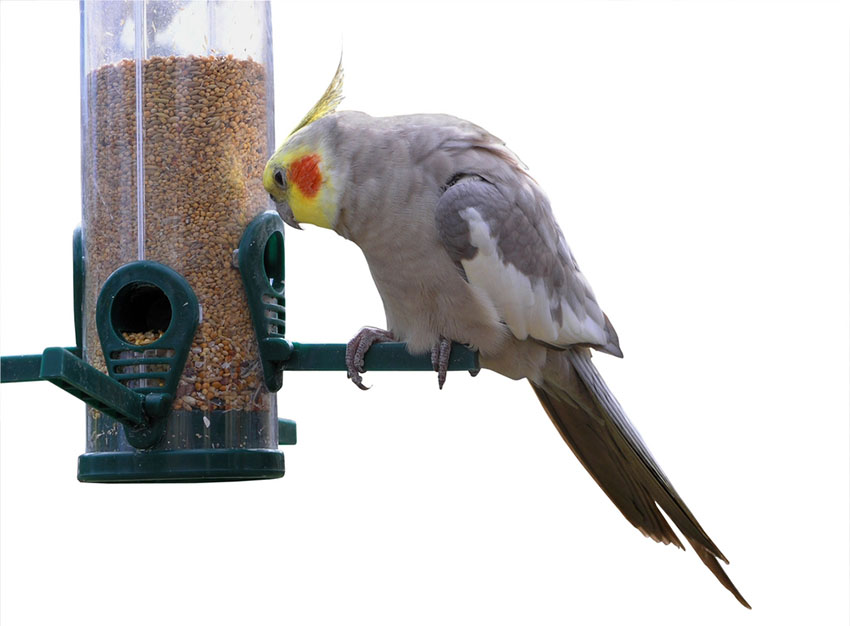A cage or enclosure is the most important purchase you will make when setting out as a parrot owner. You'll need to make sure it's fit for purpose, with plenty of space. Even a bird who spends time outside on a perch will need a cage that enables him to climb and flap his wings. The cage also needs to be safe for the birds, and easy to clean.
Regular cleaning of the base of the cage will be necessary, as droppings and discarded food mess soon builds up. A removable tray is the best solution, as it can be taken out and washed with ease.

Parrots such as this Derbyan Parakeet need a top-notch cage or aviary
Choosing a Cage
When choosing a cage or constructing an enclosure, make sure the bar spacing is appropriate for the size of your parrots. Cockatiels, and any species smaller than that, require ½ inch bar spacing; larger ones need ¾ inch, and large parrots should be given cages with 1 inch spacing. The reason is less to do with making cage-wall-climbing comfortable, and more to do with the fact that if the gaps are too wide, parrots will get their heads stuck. If the bird can squeeze its head between the bars, it will almost certainly do so.
Climbing is also important, though. Most parrots like to scale the bars, so horizontal ones are best.
Don't be tempted to buy a small cage because it will fit into a certain corner of your house. The bird must always come first, and parrots, being highly intelligent, inquisitive, and easily bored, need both space and variety. This can come from different shapes and textures of perch, climbing apparatus, and a selection of ever-changing toys. As a general rule, the more space, the better.
Positioning the Parrot Cage
Bear in mind that your parrots will spend most - or all - of their time in the cage or enclosure. It therefore needs to be in a good spot - neither too hot nor too cold, away from kitchen fumes and gas hobs, with air uncontaminated by cleaning products, tobacco fumes, aerosols such as fly sprays, paint fumes, carbon monoxide from boilers and car exhausts, and any plug-in air freshener or scented candle. These things are all pollutants that can be fatal to pet birds.

The location of the cage is very important
Cages should be placed away from drafts, so window ledges are not a good idea, Direct sunlight can cause problems too, so make sure they can escape its glare. If the birds are outside, the aviary will need sheltered spaces.
Letting Parrots Out
If a pair of parrots or a single, large bird live indoors in a relatively small cage, they will need regular free time outside the cage. They are quite capable of finding their way to and from the safety of the cage, but if you hand-tame your birds you - and they - will get a lot more from the relationship.
A large parrot will spend most of his time outside the cage, on a perch. The smaller species need regular free-flying fun too.
When your parrots are flying, it's a good idea to stay in the room with them. They are very inquisitive, and can easily get into trouble, chewing the tops of books, the edges of wallpaper and hangings, the leaves of houseplants, and anything else they can get their beaks into. Gently discourage them when they do something undesirable, and they will soon learn. Some parrots have a mischievous streak, though - one of the facts of life when you live with a creature as intelligent as a parrot!
See the Parrot training section of this guide for more details.
Cage Doors
Parrots investigate everything they can get their beaks on! Door-fasteners are always a source of fascination for them, and they will spend time trying to 'crack the code'. A less robust lock or fastener can be opened - or pulled off - by a parrot's strong beak, so your cage needs doors and fasteners that can withstand these attentions. You may have to employ a small padlock.
Food Bowls
If you have more than one bird, your enclosure will need different feeding stations. This helps prevent food fights and problems with breeding birds, who usually become very territorial and decide that all the food is theirs! One bowl per bird, and one extra - that's the best solution. Some can be on the cage floor, elevated on a bird table, or attached to the sides of the cage.

Make sure your cage has enough feeding stations to cater for hungry - and territorial - birds
Water Bowls and Bottles
Water bottles are the best way of providing water for your parrots. Open bowls and containers get dirty very quickly, due to droppings and food cast-offs. The bottle should be fastened securely to the side of the cage.
Comments
Lawanda, 27 March 2024
let me know when you have bird cages for cockatalis birds thank pearce az 85625
Ash, 18 March 2020
Awesome! No words. You always go one step beyond. There is so much great, useful information here. Thank you! Thank you! Thank you! Read our guide if you wish. petcareio Thanks again :)